Gender-Responsive Public Transportation in the Dammam Metropolitan Region, Saudi Arabia
Abstract
1. Introduction
2. Gender-Responsive Public Transportation
3. Materials and Methods
4. Study Results
4.1. Preliminary Analysis of the Data of the Women Respondents
4.2. Identification of Women’s Mobility Needs within an Urban Settings
4.3. Comparison of the Gender-Responsive Parameters in Public Transportation: Dammam Metropolitan Region vs. Best Practices
4.4. Identification of Mobility Barriers for Women Population
- In the Saudi cultural context, women’s privacy is an essential factor for any kind of service. This privacy factor is also a significant barrier for women in using the public bus within the DMR.
- It is found that there is no separate section for women passengers or any seats showing reservations for women in the existing SAPTCO public bus. Such a lack of privacy would not encourage women to use this travel mode.
- Privacy is not only a problem within the bus but also in the waiting area. The SAPTCO public bus stops do not provide any privacy measures for women, such as separate waiting areas and providing separate seats.
- Privacy is also a concern for women while using a taxi, especially when they are traveling alone.
- Security is a paramount concern that women face while traveling with public buses and taxis, as well as access to these services. Figure 10 shows the level of security of women while using and accessing different available modes. It is apparent that personal safety was at stake with all modes except the private car, i.e., about 88.6% of women were not worried while using a private vehicle. On the contrary, 34.8% of the women were anxious, and 34.3% of women were quite a bit concerned while using and accessing a SAPTCO public bus. The results highlight that the significant reason for making women feel unsafe is poorly maintained buses and bus stops where there are no specific provisions to make them convenient, accessible, and safe.
- 3.
- The lack of facilities at the SAPTCO public bus stops was a barrier for women in accessing a public bus:
- There were no waiting rooms or shades at the bus stops. It is difficult to wait in hot weather for the bus even for 5 min, particularly for kids, women, and senior citizens.
- There was a lack of information at the bus stops, i.e., there was no schedule or route map available to keep the people informed about accurate timing and travel routes, which restricted the women to use the SAPTCO bus.
- The allocated SAPTCO public bus stops were minimal on their route.
- 4.
- In addition to the limited coverage of the SAPTCO bus services, the operating hours were also minimal, i.e., the SAPTCO public bus usually operates between 3:00 p.m. and 10:00 p.m., and it has no services for the morning hours. Such unavailability and lack of accessibility hindered the women population from using this bus service because the bus stops are not available within walking distance.
- 5.
- The design of the intra-city SAPTCO public bus itself and its supporting infrastructure is not gender-responsive. For instance, the buses were high-floor vehicles, space for baby strollers/wheelchairs in vehicles was absent, and a lack of connecting footpaths for bus stops. Such a lack of focus by these authorities in the provision and improvement of public transport services increases the mobility constraints for the women population.
4.5. Proposed Gender Audit Prototype Framework
- Security, which is the prime concern for women while accessing the public transport system, should be improved by establishing CCTVs and security guarding.
- With a walking distance of up to 500 m, the extended public bus routes should be planned and implemented, having operating hours between 07:00 a.m. and 10:00 p.m.
- According to daily travel needs, more public buses should be operated for women or families, mainly from 10:00 a.m. to 05:00 p.m.
- SAPTCO currently provides special inter and intra-city transport services, including limousine and school buses. Therefore, dial-a-ride services can be provided by SAPTCO, particularly for women who tend to use mini-vans rather than the sedan-type cars. The online and phone booking facilities should be improved. SAPTCO can plan the routes based on the requests and direct the vans to specific neighborhoods.
- Separate sections for women within public buses can eliminate privacy and security concerns. Consequently, this can attract women towards the public bus.
- Buses should be redesigned with more accessible facilities for women who often travel with their children. Additionally, a specific space for baby strollers should be reserved.
- The bus stops should be designed appropriately to provide comfortable sitting facilities with suitable shade to protect users from harsh weather. The routes should also be illustrated, which could also improve accessibility.
5. Discussion and Conclusions
Author Contributions
Funding
Acknowledgments
Conflicts of Interest
References
- Rajé, F. The Lived Experience of Transport Structure: An Exploration of Transport’s Role in People’s Lives. Mobilities 2007, 2, 51–74. [Google Scholar] [CrossRef]
- Urban Mobilities in the Global South. Urban Mobilities in the Global South; Routledge: New York, NY, USA, 2017. [Google Scholar]
- Doughty, K.; Murray, L. Discourses of Mobility: Institutions, Everyday Lives and Embodiment. Mobilities 2014, 11, 303–322. [Google Scholar] [CrossRef]
- Cubells, J.; Marquet, O.; Miralles-Guasch, C. Gender and Age Differences in Metropolitan Car Use. Recent Gender Gap Trends in Private Transport. Sustainability 2020, 12, 7286. [Google Scholar] [CrossRef]
- Iqbal, S.; Woodcock, A.; Osmond, J. The effects of gender transport poverty in Karachi. J. Transp. Geogr. 2020, 84, 102677. [Google Scholar] [CrossRef]
- UN-HABITAT. Mobility as Access: Equitable Urban Mobility; United Nations Headquarters: New York, NY, USA, 2014. [Google Scholar]
- Das, A.K. Gender-Responsive Public Transport. Encycl. UN Sustain. Dev. Goals 2019, 1–12. [Google Scholar] [CrossRef]
- Uteng, T.P.; Turner, J. Addressing the Linkages between Gender and Transport in Low- and Middle-Income Countries. Sustainability 2019, 11, 4555. [Google Scholar] [CrossRef]
- Maciejewska, M.; Marquet, O.; Miralles-Guasch, C. Changes in gendered mobility patterns in the context of the Great Recession (2007–2012). J. Transp. Geogr. 2019, 79, 102478. [Google Scholar] [CrossRef]
- Al-Qarawi, N.; Kamargianni, M.; Matyas, M. She Drives KSA-Phase 1 Survey Report; IAU: Dammam, Saudi Arabia, 2018. [Google Scholar]
- AlShabibi, N. A Priminalry Determination of Factors Effecting Female Travel Demand, Pattern, and Behavior in the Kingdom of Saudi Arabia. Int. J. Psychosoc. Rehabil. 2019, 23, 11–20. [Google Scholar] [CrossRef]
- Clarke, M. Making Transport Work for Women and Men: Challenges and Opportunities in the Middle East and North Africa (MENA) Region—Lessons from Case Studies; World Bank Group: Washington, DC, USA, 2012. [Google Scholar]
- Simms, E.-M.; Stawarska, B. Introduction: Concepts and methods in interdisciplinary feminist phenomenology. Janus Head 2013, 13, 6–16. [Google Scholar]
- Jensen, O.B. Flows of Meaning, Cultures of Movements – Urban Mobility as Meaningful Everyday Life Practice. Mobilities 2009, 4, 139–158. [Google Scholar] [CrossRef]
- UNESCAP. Gender and Transport; Report Congestion Combatting No. 76, No.82; Economic and Social Commission for Asia and the Pacific Transport and Communications Bulletin for Asia and the Pacific: Bangkok, Thailand, 2013. [Google Scholar]
- Richardson, B.C. Sustainable transport: Analysis frameworks. J. Transp. Geogr. 2005, 13, 29–39. [Google Scholar] [CrossRef]
- Ogryzek, M.; Adamska-Kmieć, D.; Klimach, A. Sustainable Transport: An Efficient Transportation Network—Case Study. Sustainability 2020, 12, 8274. [Google Scholar] [CrossRef]
- UN-Women. Safe Cities Free of Violence against Women and Girls Programme; UN Women/Safe Cities Global Programme: New Dehli, India, 2009. [Google Scholar]
- UNICEF. Gender Equality Glossary of Terms and Concepts; UNICEF: Kathmandu, Nepal, 2017. [Google Scholar]
- ArrayExpress—A Database of Functional Genomics Experiments. Available online: http://www.ebi.ac.uk/arrayexpress/ (accessed on 12 November 2012).
- Basarić, V.; Vujičić, A.; Simić, J.M.; Bogdanović, V.; Saulić, N. Gender and Age Differences in the Travel Behavior–A Novi Sad Case Study. Transp. Res. Procedia 2016, 14, 4324–4333. [Google Scholar] [CrossRef]
- Peters, D. Gender and Sustainable Urban Mobility Thematic Study Prepared for Global Report on Human Settlements; United Nations: Nairobi, Kenya, 2013; Available online: https://unhabitat.org/wp-content/uploads/2013/06/GRHS (accessed on 6 September 2012).
- Uteng, T.P. Gender and Mobility in the Developing World, background paper of World Development Report 2012-Gender Equality and Development; World Bank: Washington, DC, USA, 2011. [Google Scholar]
- Law, R. Beyond ‘women and transport’: Towards new geographies of gender and daily mobility. Prog. Hum. Geogr. 1999, 23, 567–588. [Google Scholar] [CrossRef]
- Mazumder, H.; Pokharel, B. Sexual Violence on Public Transportation: A Threat to Women’s Mobility in Bangladesh. J. Aggress. Maltreatment Trauma 2018, 28, 1017–1019. [Google Scholar] [CrossRef]
- Beall, J. Urban governance: Why Gender Matters; UNDP: New York, NY, USA, 1996. [Google Scholar]
- Shirwani, R.; Gulzar, S.; Asim, M.; Umair, M.; Al-Rashid, M.A. Control of vehicular emission using innovative energy solutions comprising of hydrogen for transportation sector in Pakistan: A case study of Lahore City. Int. J. Hydrogen Energy 2020, 45, 16287–16297. [Google Scholar] [CrossRef]
- Greed, C. Overcoming the Factors Inhibiting the Mainstreaming of Gender into Spatial Planning Policy in the United Kingdom. Urban Stud. 2005, 42, 719–749. [Google Scholar] [CrossRef]
- Cresswell, T. Gendered mobilities in developing countries: The case of (urban) Uganda. In Gendered Mobilities; Routledge: London, UK, 2016; pp. 173–186. [Google Scholar]
- Greed, C. Women and Minorities Planning: The Next Steps. C. Greed Introducing Planning; Continuum: London, UK, 2000; pp. 197–210. [Google Scholar]
- Gordon, P.; Kumar, A.; Richardson, H.W. Gender Differences in Metropolitan Travel Behaviour. Reg. Stud. 1989, 23, 499–510. [Google Scholar] [CrossRef]
- Hanson, J.; Bichard, J.; Greed, C. Access to the Built Environment: Barriers, Chains and Missing Links: Initial Review; University of the West of England: Bristol, UK, 2004. [Google Scholar]
- Lu, X.; Pas, E.I. Socio-demographics, activity participation and travel behavior. Transp. Res. Part A Policy Pr. 1999, 33, 1–18. [Google Scholar] [CrossRef]
- Bianco, M.; Lawson, C. Trip chaining, childcare and personal safety: Critical issues in women’s travel behavior. In Proceedings of the Second National Conference on Women’s Travel Issues, Baltimore, Maryland, October 1996; US Department of Transportation, Federal Highway Administration: Washington, DC, USA, 1996. [Google Scholar]
- UN-HABITAT. The State of Arab Cities 2012: Challenges of Urban Transition; UN Habitat: Nairobi, Kenya, 2012. [Google Scholar]
- Skidmore, P.; Craig, J. The Art of Association: Community Organisation and the Public Realm; a Literature Review Conducted as Part of a Demos/New Opportunities Fund Project on Participation, Inclusion and Service Delivery; Demos: London, UK, 2004. [Google Scholar]
- UN-HABITAT. Gender Issue Guide. Urban Planning and Design; Miller, E., Ed.; United Nations Human Settlements Programme: Nairobi, Kenya, 2012. [Google Scholar]
- Damyanovic, D.; Reinwald, F.; Weikman, A. Gender Mainstreaming in Urban Planning & Urban Development; Urban Development Vienna; Municipal Department 18 (MA 18)–Urban Development and Planning: Vienna, Austria, 2013. [Google Scholar]
- Alotaibi, O.; Potoglou, D. Introducing public transport and relevant strategies in Riyadh City, Saudi Arabia: A stakeholders’ perspective. Urban Plan. Transp. Res. 2018, 6, 35–53. [Google Scholar] [CrossRef]
- Al-Dubikhi, S.A. Exploring the Potential for Successful Public Transport in Riyadh; University of Melbourne: Melbourne, Australia, 2007. [Google Scholar]
- Al-Atawi, A.M. Sustainable Transportation in Saudi Arabia: Reducing Barriers and Choosing Values. Int. J. Transp. 2015, 3, 81–88. [Google Scholar] [CrossRef]
- Global Mass Transit, G. Policy Review; Public transport in Saudi Arabia, Embracing comprehensive mobility. Available online: https://www.globalmasstransit.net/archive.php?id=6463 (accessed on 30 September 2020).
- Rahman, M.T.; Nahiduzzaman, K.M. Examining the Walking Accessibility, Willingness, and Travel Conditions of Residents in Saudi Cities. Int. J. Environ. Res. Public Health 2019, 16, 545. [Google Scholar] [CrossRef] [PubMed]
- Errigo, M.F.; Tesoriere, G. Urban Travel Behavior Determinants in Saudi Arabia. TeMA J. Land Use Mobil. Environ. 2018, 31–46. [Google Scholar] [CrossRef]
- Peterson, H.P.; Al Kassim, Z. A case study on perceptions of public transportation in the eastern province of saudi arabia. Transp. Probl. 2020, 15, 5–15. [Google Scholar] [CrossRef]
- Assi, K.J.; Shafiullah, M.; Nahiduzzaman, K.M.; Mansoor, U. Travel-To-School Mode Choice Modelling Employing Artificial Intelligence Techniques: A Comparative Study. Sustainability 2019, 11, 4484. [Google Scholar] [CrossRef]
- Canale, A.; Campisi, T.; Tesoriere, G.; Sanfilippo, L.; Brignone, A. The Evaluation of Home-School Itineraries to Improve Accessibility of a University Campus Trough Sustainable Transport Modes. In Computational Science and Its Applications–ICCSA 2020. ICCSA 2020. Lecture Notes in Computer Science; Gervasi, O., Murgante, B., Misra, S., Garau, C., Ivan, B., Taniar, D., Apduhan, B.O., Rocha, A., Tarantino, E., Torre, C.M., et al., Eds.; Springer: Cham, Switzerland, 2020; Volume 12250. [Google Scholar] [CrossRef]
- Assi, K.J.; Nahiduzzaman, K.M.; Ratrout, N.T.; Aldosary, A.S. Mode choice behavior of high school goers: Evaluating logistic regression and MLP neural networks. Case Stud. Transp. Policy 2018, 6, 225–230. [Google Scholar] [CrossRef]
- Nihal, M. Women Express Concern over ’no Hailing Taxi’ Law, in Saudi Women Driving; Saudi Gazette: Jeddah, Saudi Arabia, 2013. [Google Scholar]
- AlMunajjed, M. Women’s Education in Saudi Arabia: The Way Forward; Booz & Company: New York, NY, USA, 2009; Volume 1, p. 23. [Google Scholar]
- Jabeen, S.; Haq, S.; Jameel, A.; Hussain, A.; Asif, M.; Hwang, J.; Jabeen, A. Impacts of Rural Women’s Traditional Economic Activities on Household Economy: Changing Economic Contributions through Empowered Women in Rural Pakistan. Sustainability 2020, 12, 2731. [Google Scholar] [CrossRef]
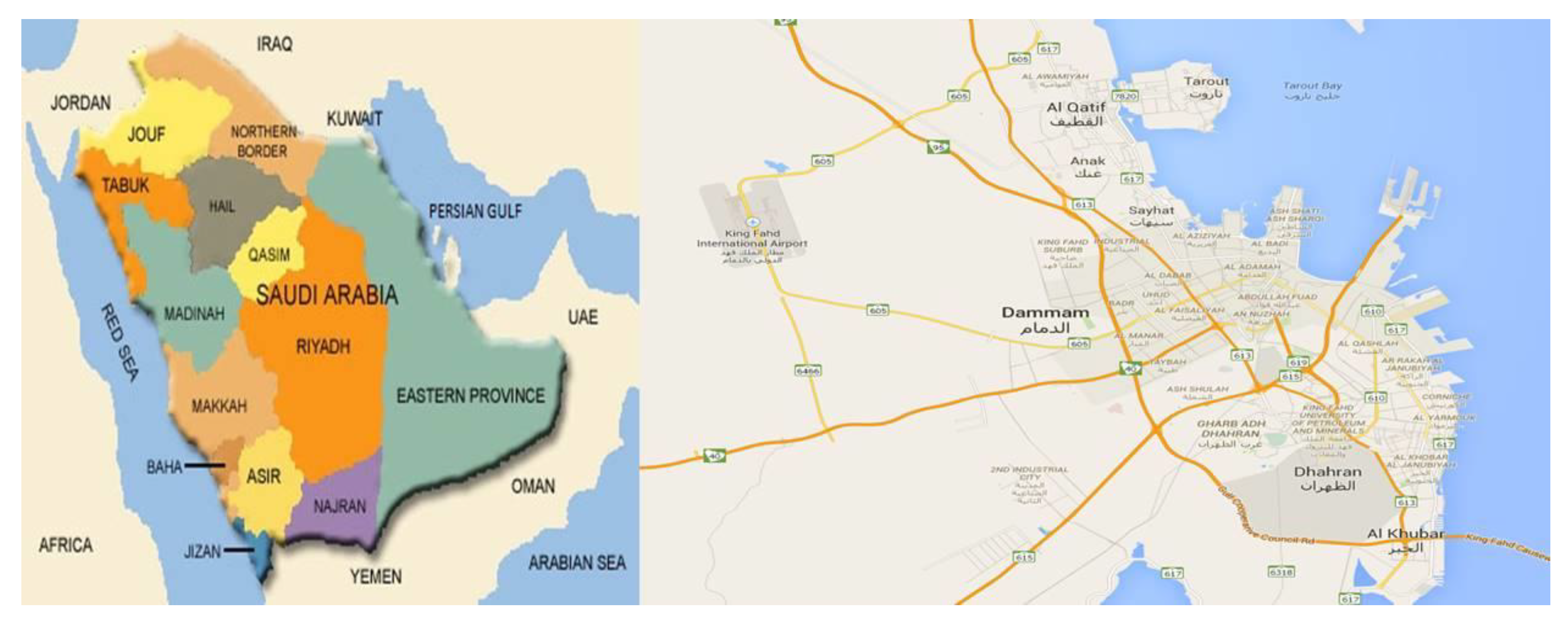
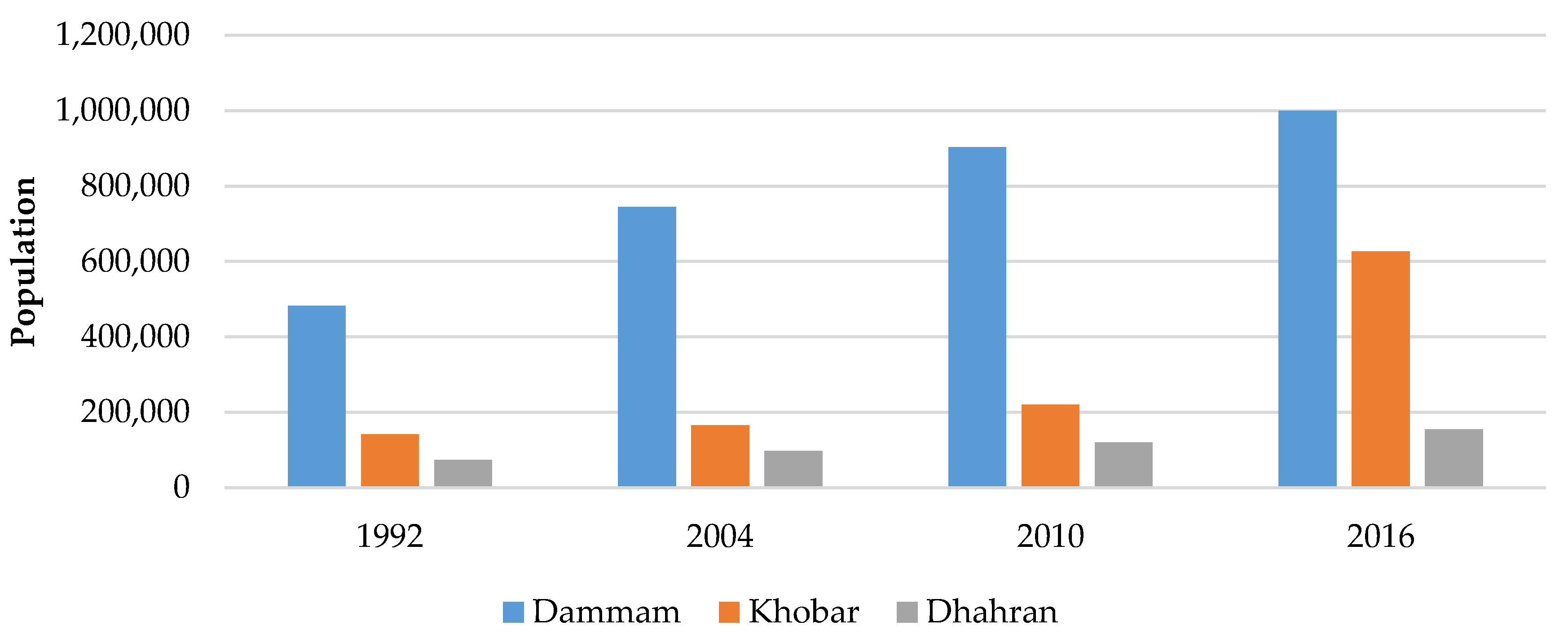
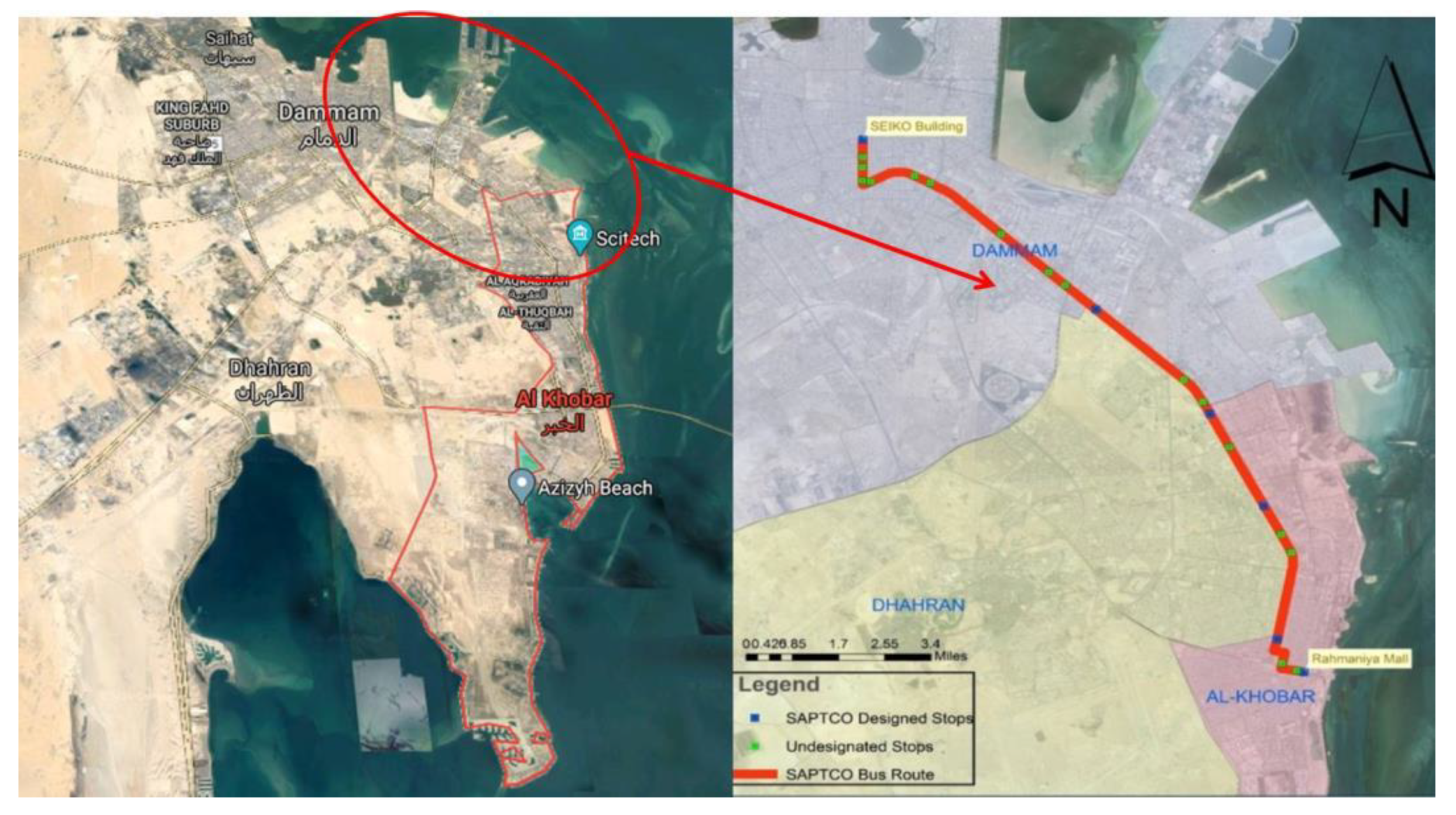
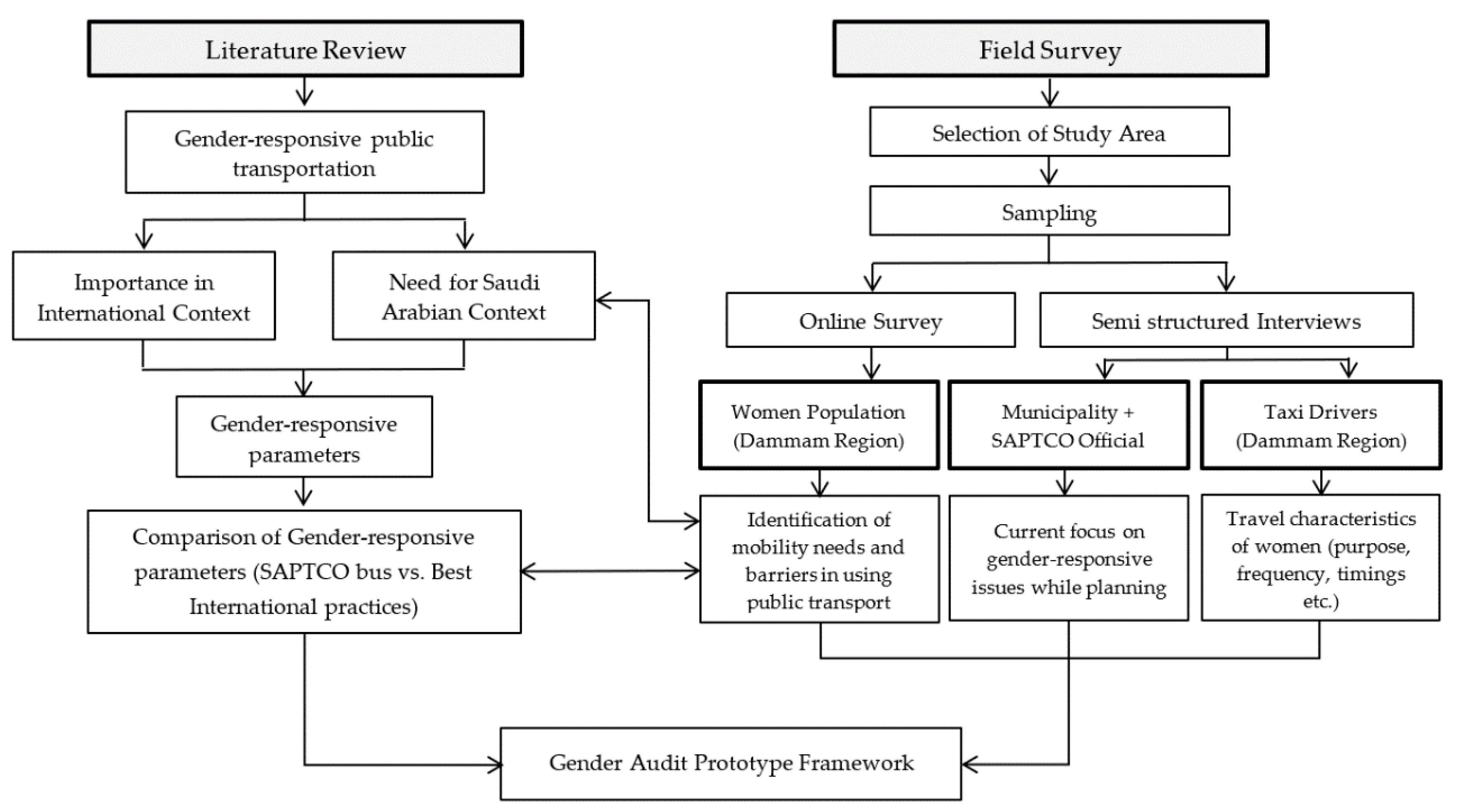
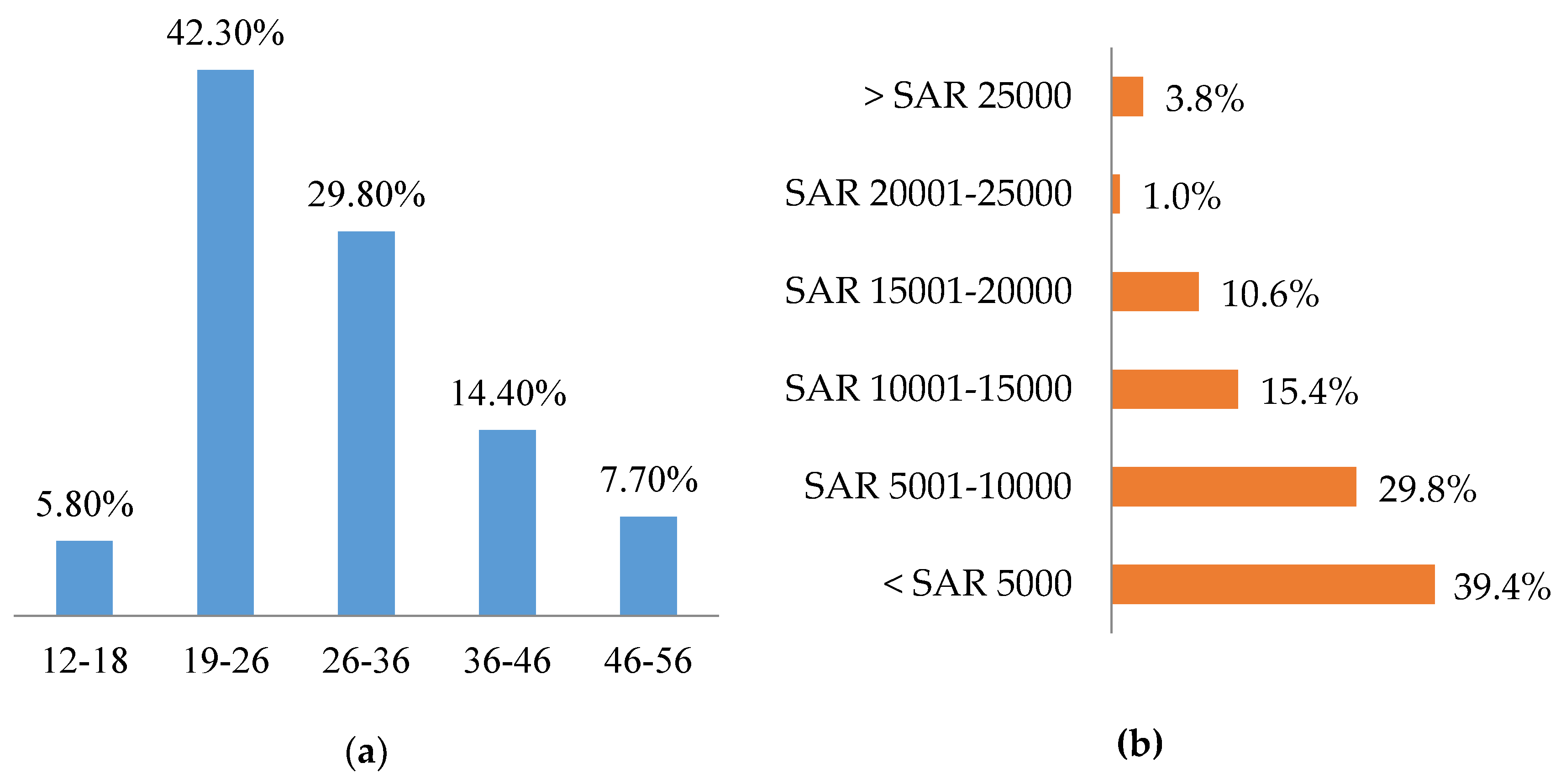
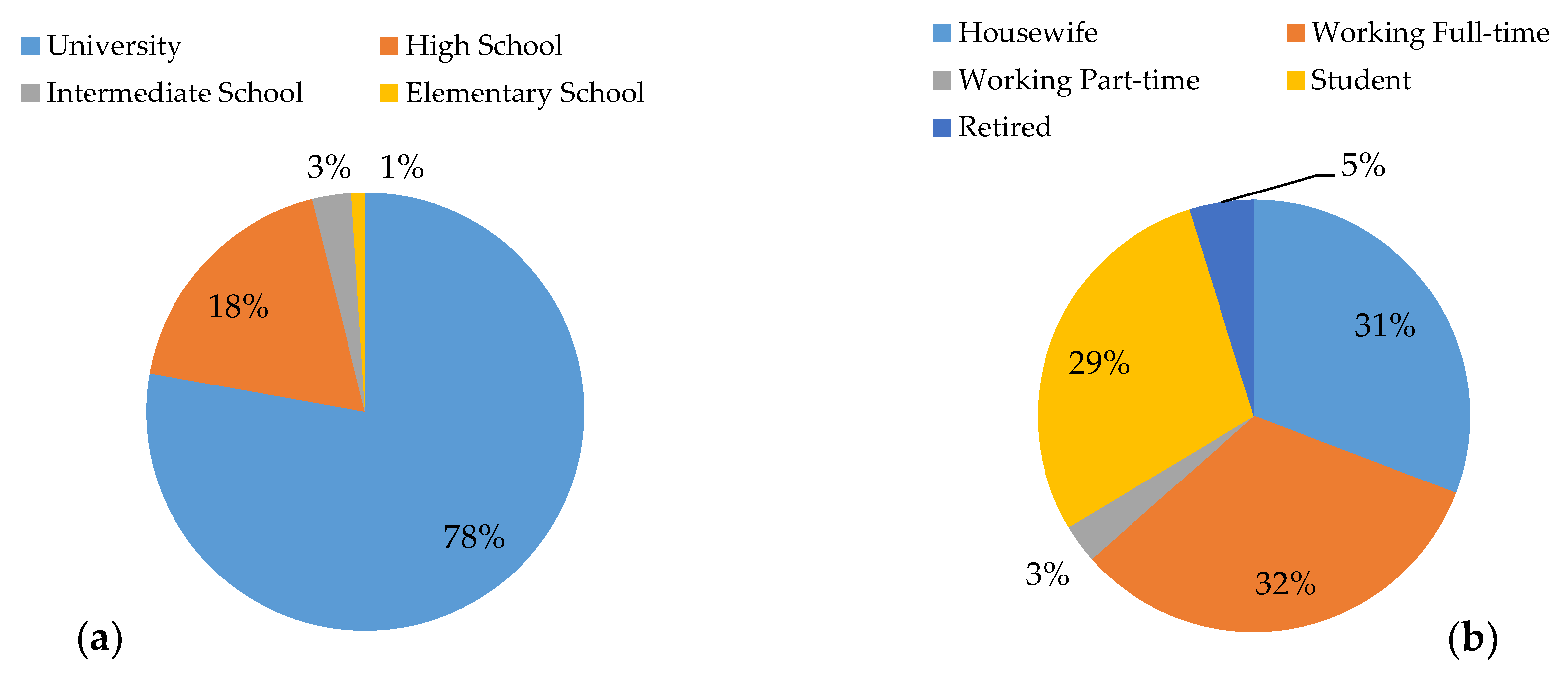
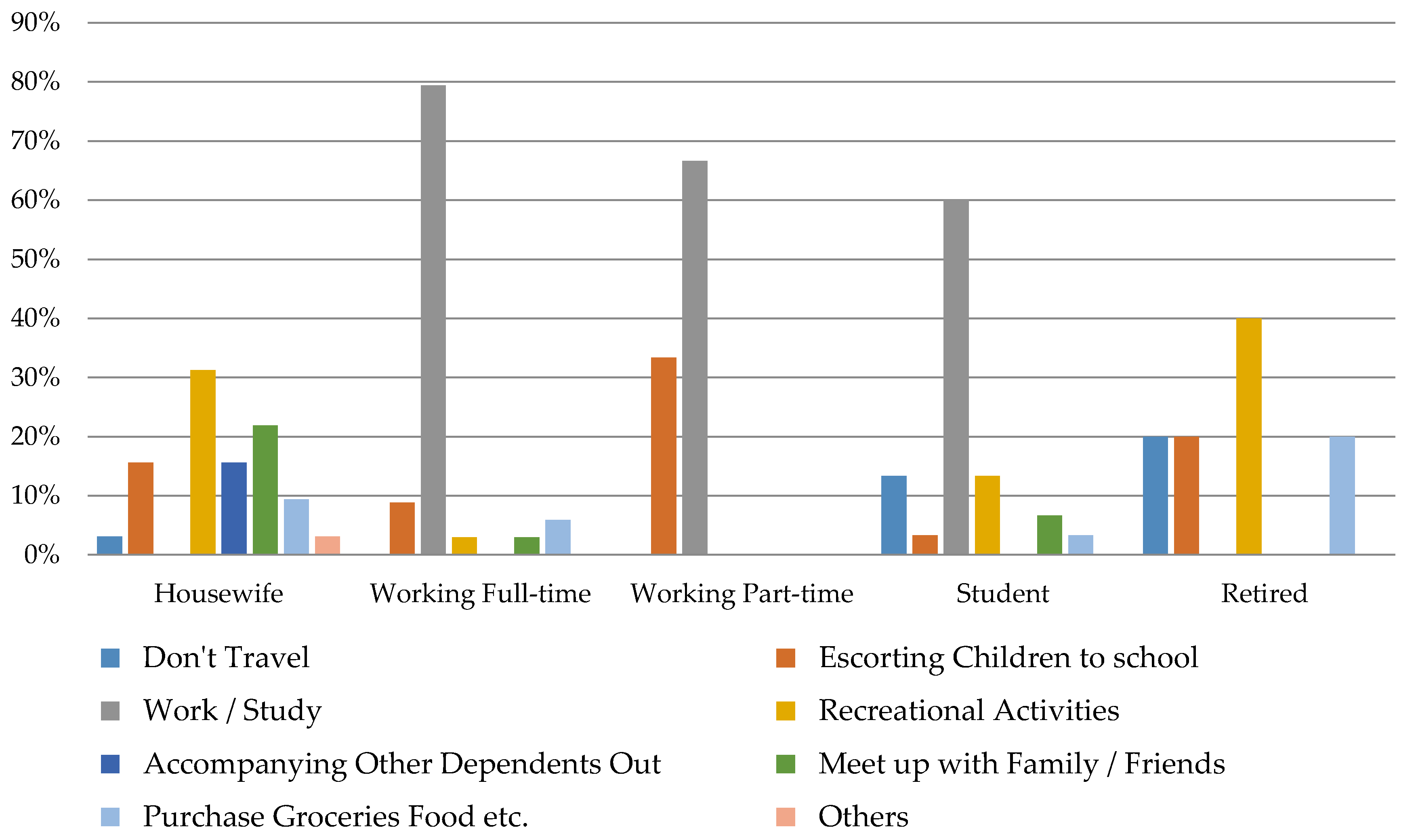

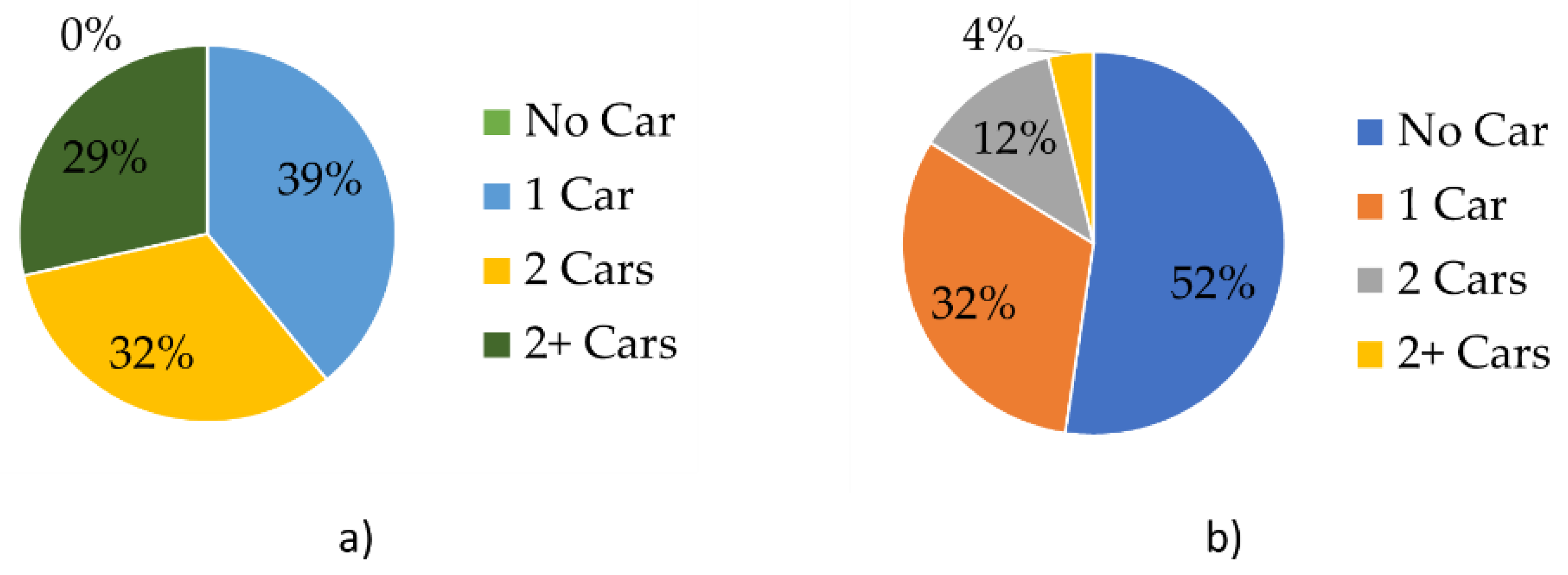
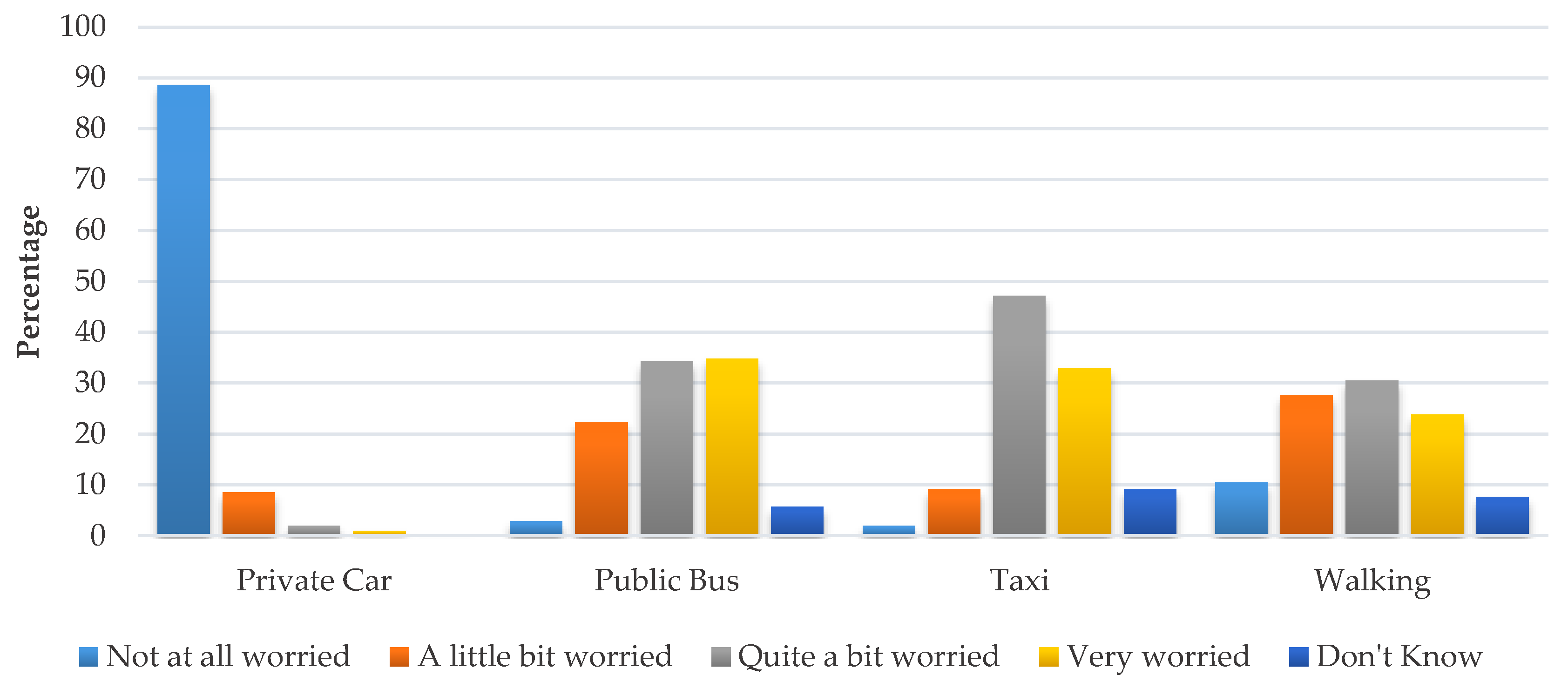
| Participants | Variables | Question Types | ||
|---|---|---|---|---|
| Multiple Choice | Likert Scale Rating (1–5) | |||
| Women | 1 | Age, education, income, and occupation | ✓ | |
| 2 | Travel characteristics (mode, purpose, and frequency) | ✓ | ||
| 3 | Reason for the preference of a mode | ✓ | ||
| 4 | Availability of the number of private cars for the entire day | ✓ | ||
| 5 | Mode choice in case of non-availability of private car | ✓ | ||
| 6 | Barriers in using public transportation | ✓ | ||
| 7 | Level of personal security in using different modes | ✓ | ||
| 8 | Reasons for feeling unsafe while using the bus and taxi | ✓ | ||
| 9 | Overall satisfaction with different transport modes | ✓ | ||
| 10 | Potential mode of public transportation for women | ✓ | ||
| SAPTCO and Municipality Officials | 1 | Focus on gender-responsive issues while planning public transport | ✓ | |
| 2 | Reasons for the restricted mobility of women with public transport | ✓ | ||
| 3 | Potential mode of public transportation for women and their roles | ✓ | ||
| Taxi Drivers | 1 | Travel characteristics of women (such as purpose and frequency, timings, traveling alone or accompanying children or male adults) during office hours | ✓ | |
| Travel within City | Occupation Level | ||||
|---|---|---|---|---|---|
| Housewife | Working Full-Time | Working Part-Time | Student | Retired | |
| Yes | 30 | 33 | 3 | 26 | 4 |
| No | 2 | 1 | 0 | 4 | 1 |
| ID | Best International Practices (BIP) | SAPTCO Public Bus (SPB) | BIP vs. SPB | ID | Best International Practices (BIP) | SAPTCO Public Bus (SPB) | BIP vs. SPB |
|---|---|---|---|---|---|---|---|
| Accessibility | Availability of Public transit services within walking distance | SAPTCO Bus is only available in some parts of the region | ± | Security | Provision of security guards at transit stops | No provision | - |
| Barrier-free access to public transit stops | Not barrier-free | ¯ | Good visibility and protection of public transit stops | Some SAPTCO Bus stops are hidden or not present in the crowded area | - | ||
| Special focus on the needs of disables | No focus on the needs of the disables or people with special | ¯ | Special focus on security (young women and older people) | Lack of focus on the security | ¯ | ||
| Low-floor vehicles | High-floor vehicles | ¯ | Provision of lightening on transit stops and in its vicinity | Not satisfactory | ¯ | ||
| Prevision of storage space for baby strollers and wheelchairs | No storage space provided for baby strollers/wheelchairs | ¯ | Information | Visual and audible real-time information | Lack of information on the bus stops | ¯ | |
| Comfort | Temperature control | Provision of ACs in public buses | + | Affordability | Low-cost transit system: | The affordable price of a Bus ticket, i.e., SAR 2 | + |
| No temperature control at bus stops | ¯ | Provision of subsidies and special packages | No subsidy is provided for any group in society | ¯ | |||
| Cleanliness of the vehicles and of the transit stops | Satisfactory clean environment provided in the SAPTCO bus | + | |||||
| Electronic ticketing | Manual ticketing | ¯ | |||||
Publisher’s Note: MDPI stays neutral with regard to jurisdictional claims in published maps and institutional affiliations. |
© 2020 by the authors. Licensee MDPI, Basel, Switzerland. This article is an open access article distributed under the terms and conditions of the Creative Commons Attribution (CC BY) license (http://creativecommons.org/licenses/by/4.0/).
Share and Cite
Al-Rashid, M.A.; Nahiduzzaman, K.M.; Ahmed, S.; Campisi, T.; Akgün, N. Gender-Responsive Public Transportation in the Dammam Metropolitan Region, Saudi Arabia. Sustainability 2020, 12, 9068. https://doi.org/10.3390/su12219068
Al-Rashid MA, Nahiduzzaman KM, Ahmed S, Campisi T, Akgün N. Gender-Responsive Public Transportation in the Dammam Metropolitan Region, Saudi Arabia. Sustainability. 2020; 12(21):9068. https://doi.org/10.3390/su12219068
Chicago/Turabian StyleAl-Rashid, Muhammad Ahmad, Kh Md Nahiduzzaman, Sohel Ahmed, Tiziana Campisi, and Nurten Akgün. 2020. "Gender-Responsive Public Transportation in the Dammam Metropolitan Region, Saudi Arabia" Sustainability 12, no. 21: 9068. https://doi.org/10.3390/su12219068
APA StyleAl-Rashid, M. A., Nahiduzzaman, K. M., Ahmed, S., Campisi, T., & Akgün, N. (2020). Gender-Responsive Public Transportation in the Dammam Metropolitan Region, Saudi Arabia. Sustainability, 12(21), 9068. https://doi.org/10.3390/su12219068








